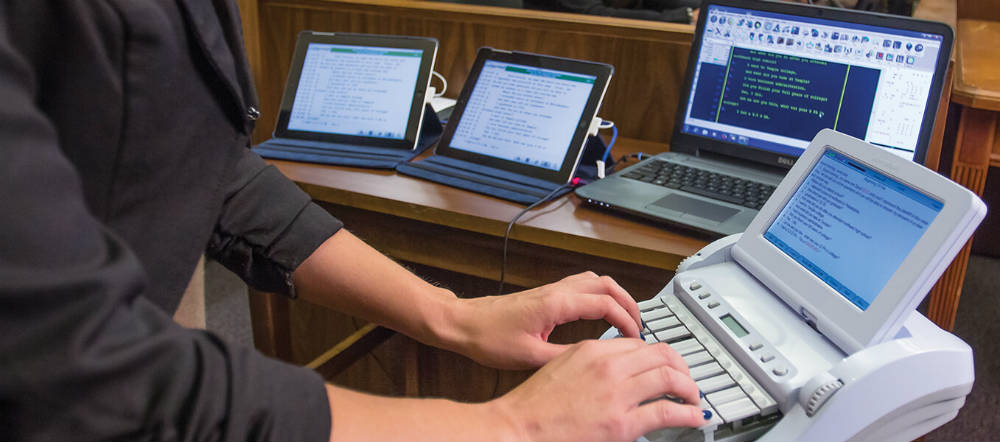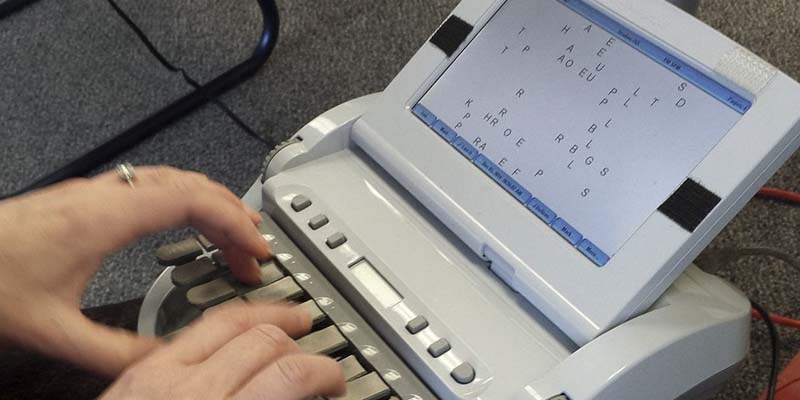Exactly How Court Reporting Functions: A Step-by-Step Overview to the Legal Process
Court reporting is a critical component of the lawful system. It entails an organized procedure that assures exact documents of procedures. From preparation to the last shipment of transcripts, each action is crucial. Recognizing exactly how court reporters operate deals insight right into the honesty of legal records. The subtleties of their job can profoundly impact lawful results, prompting inquiries regarding the techniques and technologies they employ. What are the details techniques that specify this occupation?
The Role of Court Reporters in the Legal System
Stenotype reporter play a vital duty in the lawful system by supplying precise and trustworthy records of court process. Their work guarantees that every talked word during trials, hearings, and depositions is recorded, which is critical for preserving a main record of events. This transcription is essential for allures, as it allows higher courts to assess the procedures and identify if any kind of errors were made during the test.
Additionally, court press reporters aid in protecting the honesty of the lawful process by producing verbatim documents that can be referred to by attorneys, courts, and various other parties associated with an instance. They frequently make use of customized equipment and software application to record dialogue with precision. Beyond the court, their records can offer as important historical papers, using understanding right into judicial proceedings and the legal system's functioning. Eventually, stenotype reporter add greatly to transparency and accountability in legal matters.
Getting ready for a Court Reporting Session
Prep work is crucial for an effective court reporting session, as it guarantees the accuracy and efficiency of the transcription process. Stenotype reporter begin by examining case materials, including pleadings and witness lists, to familiarize themselves with the terminology and context. They additionally make sure that they have the necessary tools, such as steno machines, notebooks, and back-up devices, on-line.
Prior to the session, interaction with lawful groups is crucial. Press reporters frequently clarify any certain demands relating to formatting or chosen terminology. Additionally, they might prepare to meet lawyers or witnesses to go over the process and verify the routine. Arriving very early to establish the devices allows for fixing prospective technological concerns. In general, thorough preparation not only improves the reporter's confidence yet additionally adds significantly to generating a accurate and clear document of the lawful proceedings.

Catching the Document: Strategies and Equipment
Making use of advanced strategies and trustworthy equipment, court reporters diligently capture the spoken word during legal procedures. They employ stenography, a method involving a specialized equipment that allows them to type several noises at the same time, therefore recording dialogue in actual time. This maker, known as a steno key-board, is furnished with secrets that represent syllables and words, enabling swift and accurate input.
In addition to stenography, court reporters may utilize audio recording gadgets as supplementary tools. These gadgets function as back-ups, making sure that no essential info is lost during proceedings. In addition, some press reporters integrate software program that improves their transcription performance, offering features such as voice recognition and automated formatting.
Correct positioning and focus are extremely important; reporters must keep focus on all audio speakers, catching subtleties and inflections that add to the record. With a combination of skill and innovation, court press reporters support the honesty of the lawful procedure by making certain a accurate and extensive record of events.
Transcribing the Procedures
Recording the process calls for court press reporters to transform talked discussion into written text with extraordinary accuracy and speed. This process usually occurs right away after the recording has been captured, making use of specialized software program that enables seamless transcription. Stenotype reporter must pay attention diligently to the sound, ensuring that every word, inflection, and time out is accurately stood for in the records.
They typically depend on shorthand systems, personal transcription skills, and progressed innovation to facilitate this job. The atmosphere in which they work can be occasionally disorderly and fast-paced, as legal proceedings usually entail multiple audio speakers and technological lingo. Stenotype reporter should likewise maintain focus to record subtleties in tone and context that may be linked here crucial for the lawful document. Ultimately, the precision of the transcription is crucial, as it acts as an official paper for future referral in legal proceedings.
Examining and Modifying the Transcript
The procedure of evaluating and modifying the transcript is essential for making certain accuracy in court reporting. Court press reporters usually team up with lawyers to clarify any type of obscurities and verify the accuracy of the recorded statements. This partnership is important for maintaining the integrity of the legal record.
Significance of Accuracy
Precision serves as the cornerstone of efficient court reporting, as even minor errors can significantly change the definition of legal proceedings. The examining and modifying procedure is important in making sure that records reflect the spoken word with integrity. Stenotype reporter diligently confirm names, technological terms, and legal jargon to preserve precision. This focus to information aids stop misunderstandings that can impact case outcomes. In addition, accuracy cultivates trust amongst legal specialists, customers, and the court, reinforcing the honesty of the judicial system. Errors can bring about appeals or disputes, making it imperative for press reporters to refine their job completely. Inevitably, the search of accuracy not just boosts the reliability of the transcript but additionally promotes the standards of the legal career.
Partnership With Lawyers
Collaboration in between court reporters and attorneys is essential during the examining and editing phase of records production. This process ensures that the final record properly mirrors the talked word and adheres to legal criteria. Lawyers usually assess transcripts for specific terms, context, and any potential mistakes that could influence the instance. Court reporters depend on attorneys' know-how to clarify unclear sections or emphasize essential statements. Reliable communication is crucial; attorneys might give comments or request corrections, which court press reporters need to attend to promptly. This collaboration not just boosts the high quality of the transcript yet also adds to a smoother lawful procedure. Inevitably, collaborative efforts cause a specific and reliable record, vital for legal proceedings and future references.
Supplying the Last Records to Clients
Upon completion of the transcription process, court press reporters diligently prepare the last document for delivery to their customers. This final transcript goes through comprehensive checking to assure accuracy, as any kind of errors can significantly influence lawful procedures. Stenotype reporter style the document according to the details needs stated by the clients or legal companies, including pagination, indexing, and any type of necessary exhibitions.

Court press reporters might offer a cover letter summing up essential information and offering more help if needed. This thorough technique assurances that customers receive a sleek, specific, and easily navigable transcript, crucial for their legal requirements.
Regularly Asked Concerns
What Certifications Are Required to End Up Being a Stenotype Reporter?
To become a stenotype reporter, people generally require a secondary school diploma, conclusion of a court reporting program, and certification or licensure, relying on state demands. durham court reporting. Effectiveness in shorthand and modern technology Recommended Reading is additionally crucial for success
For how long Does It Take to Complete Court Reporting Training?
Typically, completing court reporting training takes in between 18 months to four years, relying on the program's intensity, the student's rate, and the particular demands of the territory in which they wish to practice.

What Is the Typical Income of a Court Press reporter?
The average salary of a stenotype reporter varies by place and experience, generally ranging from $45,000 to $100,000 every year (durham court reporting). Variables such as specialization and demand can significantly influence their incomes in various areas
Are Court Reporters Required to Have Accreditation?
Court reporters are usually called for to obtain qualification, which guarantees they possess the needed abilities and understanding for accurate transcription. Certification demands can vary by state or territory, showing expert requirements within the legal community.
Can Court Reporters Job From Another Location or Freelance?
Court reporters can function remotely or freelance, offering versatility in their occupation. Lots of use modern technology to transcribe proceedings from various locations, enabling diverse opportunities in the legal area while preserving a work-life balance.
Court press reporters play a necessary function in the lawful system by supplying precise and trusted records of court process. In addition, court press reporters aid in preserving the stability of the lawful procedure by producing verbatim records that can be referred to by legal representatives, judges, and other parties involved in a situation. Using innovative strategies and trusted devices, court reporters diligently capture the spoken word during legal proceedings. Court press reporters need to additionally maintain concentration to catch nuances in tone and context that might be vital for the legal record. To become a court reporter, individuals normally need a high school diploma, completion of a court reporting program, and certification or licensure, depending on state demands.